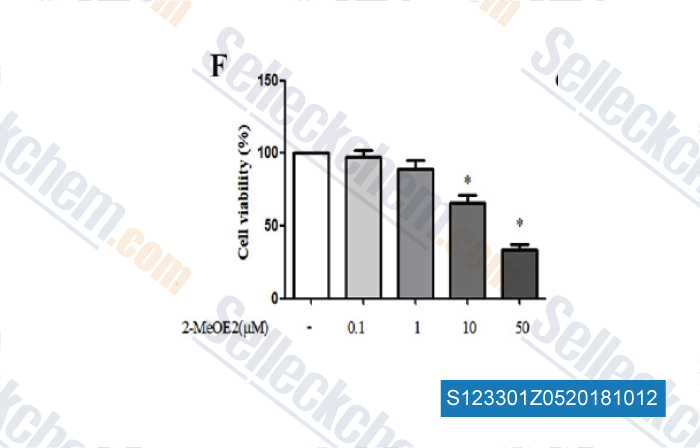|
How to Cite 1. For In-Text Citation (Materials & Methods): 2. For Key Resources Table: |
||
|
Toll Free: (877) 796-6397 -- USA and Canada only -- |
Fax: +1-832-582-8590 Orders: +1-832-582-8158 |
Tech Support: +1-832-582-8158 Ext:3 Please provide your Order Number in the email. We strive to reply to |
Technical Data
| Formula | C19H26O3 |
||||||||||
| Molecular Weight | 302.41 | CAS No. | 362-07-2 | ||||||||
| Solubility (25°C)* | In vitro | DMSO | 60 mg/mL (198.4 mM) | ||||||||
| Water | Insoluble | ||||||||||
| Ethanol | Insoluble | ||||||||||
| In vivo (Add solvents to the product individually and in order) |
|
||||||||||
|
* <1 mg/ml means slightly soluble or insoluble. * Please note that Selleck tests the solubility of all compounds in-house, and the actual solubility may differ slightly from published values. This is normal and is due to slight batch-to-batch variations. * Room temperature shipping (Stability testing shows this product can be shipped without any cooling measures.) |
|||||||||||
Preparing Stock Solutions
Biological Activity
| Description | 2-Methoxyestradiol (2-MeOE2, NSC 659853, 2-ME2) depolymerizes microtubules and blocks HIF-1α nuclear accumulation and HIF-transcriptional activity. This compound also induces both autophagy and apoptosis in various carcinogenic cell lines. | |||
|---|---|---|---|---|
| Targets |
|
|||
| In vitro | 2-Methoxyestradiol (2-MeOE2) exhibits the inhibitory activity of cellular proliferation in a breast carcinoma cell line MDA-MB-435 and an ovarian carcinoma cell line SK-OV-3 with IC50 of 1.38 μM and 1.79 μM, respectively. Furthermore, it also inhibits cellular microtubule depolymerization in rat aortic smooth muscle A-10 cells with EC50 of 7.5 μM. [1] This compound inhibits proliferation of MCF-7 and BM cells with IC50 of 52 μM and 8 μM. [2] In MDA-MB-231 cells, it inhibits HIF-1-mediated transcriptional activation of target genes without affecting the transcription of HIF-1α itself. [3] A recent study shows that 2-MeOE2 (0.5 μM), blocks TGF-β3-induced expression of collagen (Col) type I(αI), Col III(αI), plasminogen activator inhibitor (PAI) 1, connective tissue growth factor (CTGF), and α-smooth muscle actin (α-SMA). Moreover, it ameliorates TGF-β3-induced Smad2/3 phosphorylation and nuclear translocation, and inhibits TGF-β3-induced activation of the PI3K/Akt/mTOR pathway. [4] |
|||
| In vivo | In a 9L rat glioma (9L-V6R) rat model, 2-Methoxyestradiol (2-MeOE2) significantly decreases HIF-1 activity and inhibits tumor growth in a dose-dependent manner, with a 4-fold reduction at 60 mg/kg/day and a 23-fold reduction at 600 mg/kg/day, respectively. [5] |
Protocol (from reference)
| Kinase Assay: |
|
|---|---|
| Cell Assay: |
|
| Animal Study: |
|
References
|
Customer Product Validation
-S123306W0220150907.gif)
-
Data from [ , , Oncotarget, 2015, 6(4): 2250-62 ]
-S123306W2020150907.gif)
-
Data from [ , , Nucleic Acids Res, 2015, 43(10): 5081-98 ]

-
Data from [ , , Mol Cell Endocrinol, 2018, doi:10.1016/j.mce.2018.05.002 ]
Selleck's 2-Methoxyestradiol (2-MeOE2) Has Been Cited by 93 Publications
| Histone methyltransferase ASH1L primes metastases and metabolic reprogramming of macrophages in the bone niche [ Nat Commun, 2025, 16(1):4681] | PubMed: 40394007 |
| Combined Graphene Oxide with 2-Methoxyestradiol for Effective Anticancer Therapy in-vitro Model [ Int J Nanomedicine, 2025, 20:933-950] | PubMed: 39850060 |
| EBV-associated epithelial cancers cells promote vasculogenic mimicry formation via a secretory cross-talk with the immune microenvironment [ Theranostics, 2024, 14(13):5123-5140] | PubMed: 39267775 |
| IL-33 Accelerates Chronic Atrophic Gastritis through AMPK-ULK1 Axis Mediated Autolysosomal Degradation of GKN1 [ Int J Biol Sci, 2024, 20(6):2323-2338] | PubMed: 38617533 |
| The ANGPTL4-HIF-1α loop: a critical regulator of renal interstitial fibrosis [ J Transl Med, 2024, 22(1):649] | PubMed: 38992710 |
| The role of HIF-1α/BNIP3/mitophagy in acrylonitrile-induced neuronal death in HT22 cells and mice: A potential neuroprotection target [ Chem Biol Interact, 2024, 406:111327] | PubMed: 39615733 |
| HIF-1 inhibition reverses opacity in a rat model of galactose-induced cataract [ PLoS One, 2024, 19(2):e0299145] | PubMed: 38416732 |
| MiR-122-5p regulates the mevalonate pathway by targeting p53 in non-small cell lung cancer [ Cell Death Dis, 2023, 14(4):234] | PubMed: 37005437 |
| Signaling metabolite succinylacetone activates HIF-1α and promotes angiogenesis in GSTZ1-deficient hepatocellular carcinoma [ JCI Insight, 2023, 8(23)e164968] | PubMed: 37906252 |
| Ginkgo biloba extract attenuates cisplatin-induced renal interstitial fibrosis by inhibiting the activation of renal fibroblasts through down-regulating the HIF-1α/STAT3/IL-6 pathway in renal tubular epithelial cells [ Phytomedicine, 2023, 115:154809] | PubMed: 37087791 |
RETURN POLICY
Selleck Chemical’s Unconditional Return Policy ensures a smooth online shopping experience for our customers. If you are in any way unsatisfied with your purchase, you may return any item(s) within 7 days of receiving it. In the event of product quality issues, either protocol related or product related problems, you may return any item(s) within 365 days from the original purchase date. Please follow the instructions below when returning products.
SHIPPING AND STORAGE
Selleck products are transported at room temperature. If you receive the product at room temperature, please rest assured, the Selleck Quality Inspection Department has conducted experiments to verify that the normal temperature placement of one month will not affect the biological activity of powder products. After collecting, please store the product according to the requirements described in the datasheet. Most Selleck products are stable under the recommended conditions.
NOT FOR HUMAN, VETERINARY DIAGNOSTIC OR THERAPEUTIC USE.
